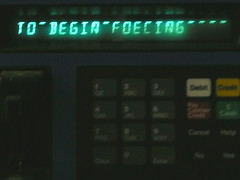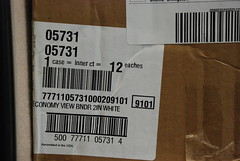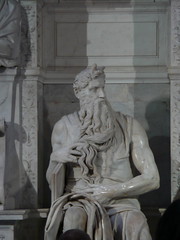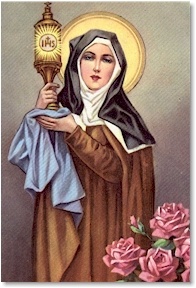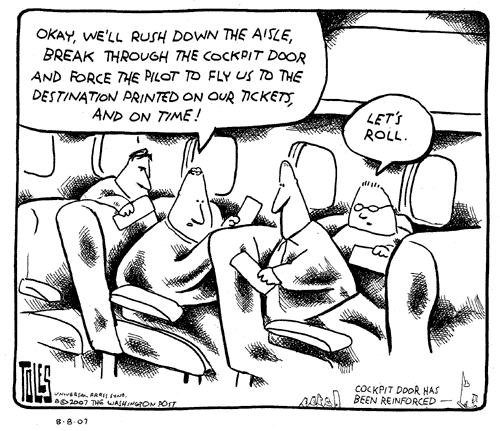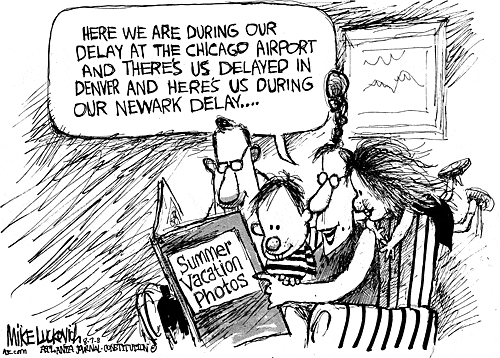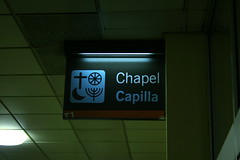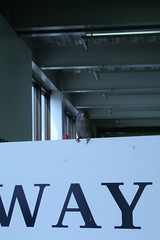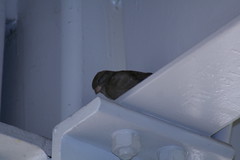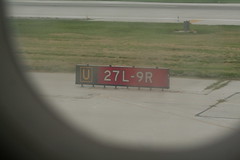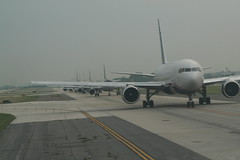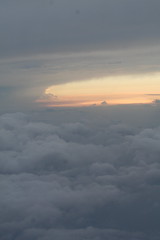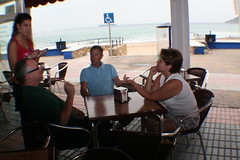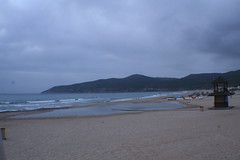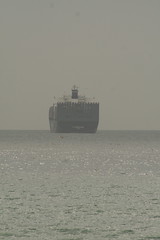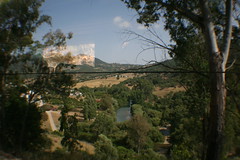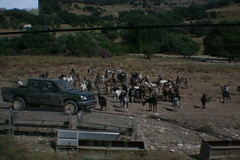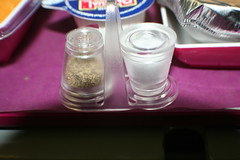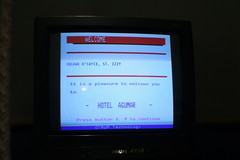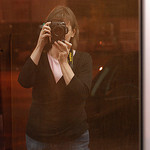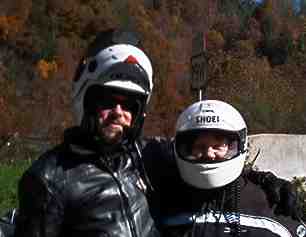Or, you knew you'd have to pay some sort of "tourist tax" this trip...
~~~~~~~~~~~~~~~~~~~~~~~~~~~~~~~~~~~~~~~~~
We got up early and made it to the Port by 8 AM, where we were given stickers and told to go to another area and wait—someone would come for us; we’d been stickered.
8:15—Someone spotted us and told us to go upstairs and wait; he’d be back in 15 minutes.
8:45—We saw “our guy” again as he motioned a group to go through security. We followed, but when boarding passes to the ferry were passed out, they were two short. It turns out this was the wrong group for us (US high schoolers on an EF Tours package). We headed back out of the security area and found “our guy,” who had our boarding passes. He gave us no information as to what would happen when we docked in Ceuta and did not board the ferry. No one with similar stickers was on the boat.
Easy ~35 minute ride to Ceuta (Arabic: Sebta).

Ferry to Ceuta
~~~~~~~~~~~~~~~~~~~~~~~~~~

Bird Flu alert in Ferry Terminal. Avoid visiting ... markets ...
When we got off the boat, a Moroccan guide for a different group saw our stickers and told us to go outside where our guide would find us. And so he did. We were approached by our new guy, who told us that his name was Ahmet and that he would be taking care of us today. He took our passports and our tickets, told us to go to the "meecrobus" (microbus) at the end of the line of big touring buses, and wandered off somewhere.
Eventually there were seven passengers on the bus, two of whom had stickers like ours but didn’t speak English. Ahmet came back with our driver, and we were off to a day of a completely different sort of adventure than what we thought we’d bought.
1st stop, border crossing from Ceuta (an independent Spanish Colony) to Morocco. Ahmet took our passports and entry/exit documents “somewhere.” He came back and announced that he had sold our passports. This did not reassure the young Scottish couple with us, who were already concerned due to Ahmet’s sketchy ID badge, lack of uniform, and general uncommunicativeness.
Bus ride to Tetouan, Ahmet’s home town. It had been a Spanish protectorate, then became Moroccan-ruled under Mohammed V (they’re now under Mohammed VI). Ahmet had a few themes: Muslims and Jews get along in peace here, there is lots of progress (we certainly saw lots of building projects), the seaside resorts made great places to come for vacation, there was no terrorism, and handcrafts are very important to the Moroccan economy.
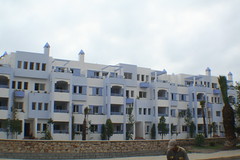
New construction for vacation/retirement homes
We stopped for 1€ camel rides, a roadside attraction that all of the tour guides know about and support. We saw the same group of US high schoolers from the ferry terminal among the buses stopped here. The only other attraction at this wide shoulder in the road was a trash fire. Several of the camels were muzzled, and one was hobbled. Recalcitrant beasts, no doubt.
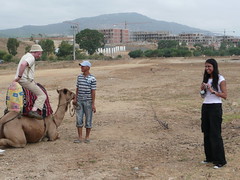
Scottish couple & the Camels
~~~~~~~~~~~~~~~~~~~~~~~~~~~
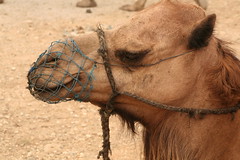
~~~~~~~~~~~~~~~~~~~~~~~~~~~
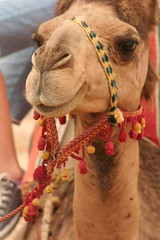
~~~~~~~~~~~~~~~~~~~~~~~~~~~
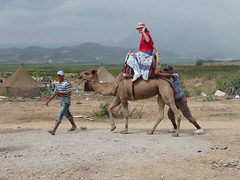
My first camel ride
Arrival in Tetouan: We walked past (a? the? it wasn't clear) Presidential Palace then into the old city (“medina” in Arabic). [The medina of Tetouan is a UNESCO world heritage site.]
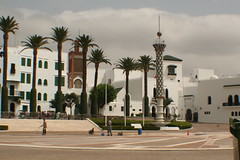
Presidential Palace
~~~~~~~~~~~~~~~~~~~~~~~~~~~~~
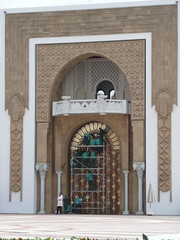
Cleaning the door of the mosque
Ahmet had told us repeatedly that this was our lucky day since it was a special Muslim Market and the Berber people would be in town.He showed us some architectural features of the Medina (wall colors indicating what section of the medina we were in, door styles & markings, etc.) but walked us very quickly past stalls, tailors, little tiny shops, and other points of interest.
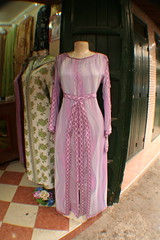
Seen in tailor shop
~~~~~~~~~~~~~~~~~~~~~~~~~~~~
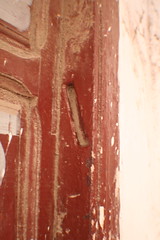
Marking seen on Jewish homes
~~~~~~~~~~~~~~~~~~~~~~~~~~~~
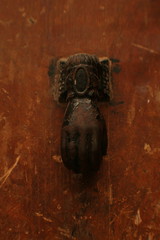
Door knocker
~~~~~~~~~~~~~~~~~~~~~~~~~~~~
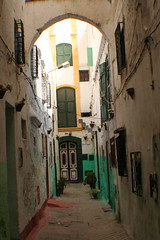
In later discussions we discovered that all the paying members of our group had expected to be able to stop at these sorts of places to buy souvenirs and gifts. Instead, Ahmet took us to “a typical Moroccan pharmacy” where a guy in a lab coat gave a spiel on herbs. I should have noticed the lack of non-herbal merchandise, especially when third world pharmacies are well-known in public health circles as sources of all sorts of “generic” antibiotics and other remedies. Wherever we were, it wasn’t “a typical Moroccan pharmacy.” It turns out that this was a harbinger of the rest of the day—hurry past the locals and be herded into someplace that exists only for tourists.
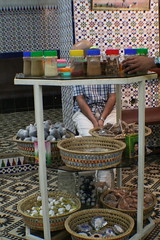
I bought some green tea and a curry-type spice. Izzy, who had been complaining of a stiff neck for a couple of days and had skipped my adventure of a camel ride, paid 5€ for a massage.
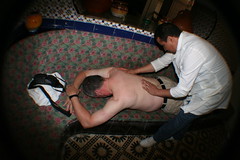
Out into the medina again, walking past poultry vendors and their still-living wares, shops selling ready-mix wall paints, toys, clothes, produce, etc.
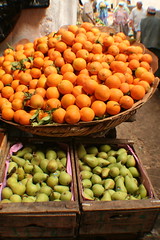
Open-air stalls in Tetouan medina
~~~~~~~~~~~~~~~~~~~~~~~~~~~~~~~~
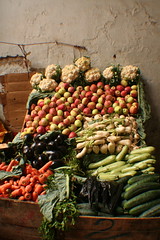
~~~~~~~~~~~~~~~~~~~~~~~~~~~~~~~~

~~~~~~~~~~~~~~~~~~~~~~~~~~~~~~~~
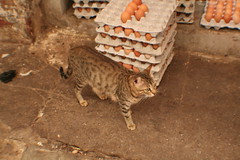
~~~~~~~~~~~~~~~~~~~~~~~~~~~~~~~~
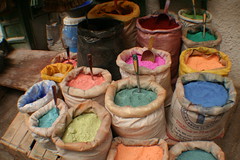
~~~~~~~~~~~~~~~~~~~~~~~~~~~~~~~~

~~~~~~~~~~~~~~~~~~~~~~~~~~~~~~~~
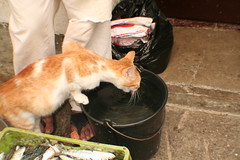
~~~~~~~~~~~~~~~~~~~~~~~~~~~~~~~~
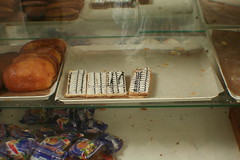
Izzy managed to stop for one of these
Ignoring the fact that we all just wanted a guide to take us to the little shops, our guide took us to an “Art Institute.” I knew something was up when the seven of us were separated into four groups (three couples and the single Indian guy from Michigan/Texas/Bombay) and handed off to four different guys wearing djellabas and pointed shoes (each with limited English and a silent assistant). While the one guy described various sorts of rugs, the other unrolled examples of them: silk, silk/wool, knotted, woven,embroidered, Berber, etc., all very beautiful, very large (“we can ship anywhere”), and doubtless very expensive.
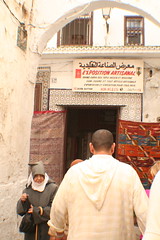
Ahmet, @ the entrance to the Art Institute
~~~~~~~~~~~~~~~~~~~~~~~~~~~~~~~~~
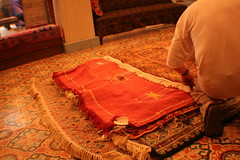
Izzy checks out the rugs
They asked us to join them in mint tea: “Sugar? No sugar?” I asked for no sugar, but discovered a thick layer of undissolved sugar in the bottom of my cup about the time I finished the liquid (to which I had added sweetener and so hadn’t noticed the sugar). This did nothing for my mood. I was already feeling trapped in a high-pressure sales meeting; I’m sure that’s why they had separated members of our group. We had no need of a rug, and Izzy was ready to walk away, but I saw an intricately woven table covering I wanted (we got it for 600 dirham, about $75 US) and they kept trying to convince us to add a rug to it and “put on credit card.” I think they are convinced that all Westerners are rich; how else to afford this travel?
Lunch was at a restaurant designed for and frequented only by tour groups. The only locals in the place were the wait staff, the musicians, the dancers, the whirling dervish... all of whom had their hands out. Our guide and his assistant in the medina (an older man named Mohammet who trailed at the end of the group to make sure none of us “got lost” and who kept pointing out photo ops for me) did NOT eat with us, but went somewhere else. (Midday prayers?)
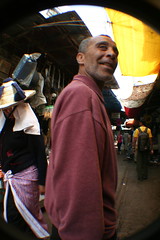
Mohammet, encouraging me to snap a short of the Berber woman
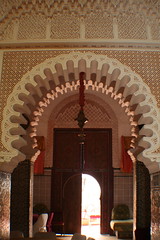
Hmmm, this looks like yesterday's travel poster
~~~~~~~~~~~~~~~~~~~~~~~~~~~~~
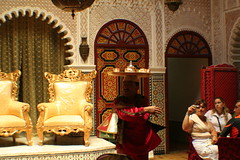
Whirling tea set Dervish
~~~~~~~~~~~~~~~~~~~~~~~~~~~~~
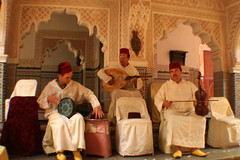
~~~~~~~~~~~~~~~~~~~~~~~~~~~~~
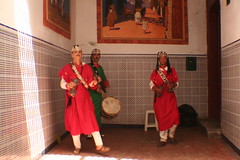
Lunchtime sights
Over lunch the seven of us on the tour discussed our rug purchases. One guy had bargained his rug from an initial price of €280 down to a mere €40; he had been raised in the US but was Indian and had been spending some time back in the homeland. He said, “I just bobbled my head and told them in broken English that I was a poor student.” We were all impressed.
Izzy asked if any of us had noticed a guy in a peach and white striped Levi Strauss shirt who had been shadowing us. At first he thought the guy was going for my bag, but then noticed that he was hanging too far back. No one else had seen him. But when Ahmet and Mohammet reappeared and led us out of the restaurant, Peach Shirt picked up our tail again within a couple of corners. He followed us all the way back to our minibus, where Mohammet said goodbye and asked for a tip and Peach Shirt just vanished. Izzy wonders whose minder he was. [He’s visible in the striped shirt here and here.
As we drove toward Tangier, I raised the question we had all discussed at lunch: would we be able to shop for small souvenirs? Ahmet seemed surprised, and said he had given us the chance to shop, and I mentioned that the places he’d taken us were very expensive. His reply was, “perhaps nothing will please madam; some people spend only $75 and think it is too much, but if we stopped everywhere someone wanted to, who would pay when you missed your boat?” Shocked that he knew how much money I had spent in the “Art Institute” (& in which currency!), I help up my hand to stop the conversation—there was nothing I could say that would not provoke him further.
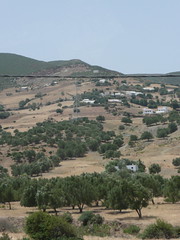
I also knew that my own attitude was not the best. I had a headache from the potions at the “pharmacy” and some people smoking a couple of tables over at lunch, and I had been overly loud asking the Eastern European couple traveling in our group (the ones with stickers like ours) not to light up at our table. And I now suspected that everything we did or said when Ahmet was not around got back to him and that he was getting kickbacks from our purchases to supplement his own income. I was also a little afraid of being set out of the bus. So I took an Imitrex and napped the rest of the way to Tangier.
Into Tangier: We passed a bullring on the way to the Place de España where we got out and walked quickly into the medina.

We immediately stopped for Ahmet to buy olives at a local stall. We weren’t allowed. We passed many more shops; there was a lot more mass merchandise here and not so many handcrafts. There were also many more people walking up to us with hands full of things for us to buy, all of whom were shouted away by Ahmet, who kept us moving.
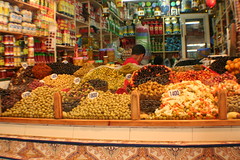
Olive stand
~~~~~~~~~~~~~~~~~~~~~~~~~~~~~~~
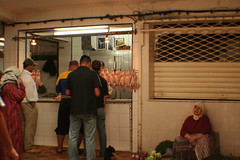
Open air poultry market
~~~~~~~~~~~~~~~~~~~~~~~~~~~~~~~
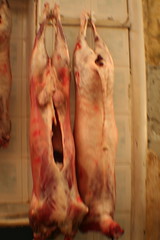
Who, in this Muslim/Jewish enclave is going to buy these?
~~~~~~~~~~~~~~~~~~~~~~~~~~~~~~~
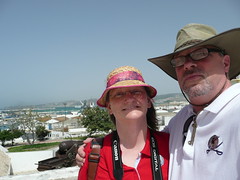
Closest we got to the Bay of Tangier
After a bit of a walk, we were taken somewhere, “with clean washrooms” in case we wanted “to freshen up” after the long ride. It was a three-story warehouse of beautiful knickknacks. There were no prices and very few pushy, hovering people. Realizing we weren’t going to get the chance to shop elsewhere, Izzy and I picked up some simple leather goods.
Back outside, Ahmet apologized to me for our tiff earlier. I realized that he wanted a tip. Izzy had earlier mentioned that as Ahmet walked down the streets, people kept approaching Ahmet; he would give them some money and say something, and they would duck into a store and come back further up the street with a bag or package for him.
At one point in the medina, we definitely saw marijuana being passed from hand to hand by people out on the street.
Back on the bus for the long ride back to Ceuta. We stopped once for Ahmet to buy a large melon from a roadside stand (it was later taken by our bus driver to deliver to someone in Ceuta on Ahmet’s behalf), and another time for Ahmet to drop off a package for someone working at a gas station. We got stuck on mountain roads behind a hay truck with V-shaped load (wider at the top than at the bottom). It wasn’t the slowest thing on the road though, because we eventually caught up with a truck hauling a load of cement bricks, and that truck was stuck behind the really slow hay truck. Hay truck, brick truck, hay truck, “microbus.” Folks were mainly quiet on this leg of the trip, napping. Ahmet had given up his tour guide patter and was talking on both his cell phone and the driver’s.
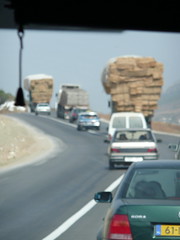
A bit blurry, but you can see the hay truck, brick truck, hay truck sequence.
~~~~~~~~~~~~~~~~~~~~~~~~~~~~~~~

Closer view of hay truck
~~~~~~~~~~~~~~~~~~~~~~~~~~~~~~~

Taste of Home
~~~~~~~~~~~~~~~~~~~~~~~~~~~~~~~
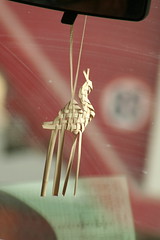
Seen in front of our microbus
~~~~~~~~~~~~~~~~~~~~~~~~~~~~~~~
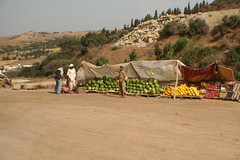
Roadside produce stand
Back to Ceuta: We got our passports back at the border. We had missed our scheduled ferry at the terminal (hay trucks) and were assigned to the next one out. They are running 24/7 in July and August for all those Moroccans coming home on holiday. So that’s what would have happened if we had stopped to shop from local stalls (!)
While awaiting our new boarding passes, we were approached by a mother and child selling jewelry, including necklaces for 1€ each. I used the last 5€ I had with me and she threw in a sixth necklace for free. The young Scottish couple did the same, glad as I was to be able to get some sort of souvenir.
Izzy and I each tipped Ahmet $10 and asked him to share with the bus driver, who had disappeared with the melon after doing such a good job on the roads. We hope he got his cut of the tip.
On the boat, we vented and laughed with the Scottish couple, who were very funny. It seems Ahmet had been rude to the Scottish girl when she’d tried to find out what he was doing with their passports (he had been as brusque and uninformative with them as he had been with us, apparently). I think it’s just a major insult to a Muslim man to be questioned by a woman. Definitely NOT the American sense of customer service. Good cross-cultural learning opportunity.
We all realized that Ahmet was at least getting kickbacks from these places (if not related to their owners) which were convenient to but totally separate from the life of the medinas. None of us felt we’d had a real exposure to Morocco, but we all expressed interest in getting exposure some day.
Back in Algeciras, Izzy and I hit the ATM and hailed a cab. When we got back to our hosts’ house, it was a bit after 9:30 and still quite light out. They were at a wedding, so we assembled a dinner of (ham and) cheese sandwiches, greens beans with lemon, and vino tinto (Izzy) followed by an ice cream bar (also Izzy).
We took showers and headed off to bed well before our hosts arrived home ~3 AM.
Flickr sets for today:


